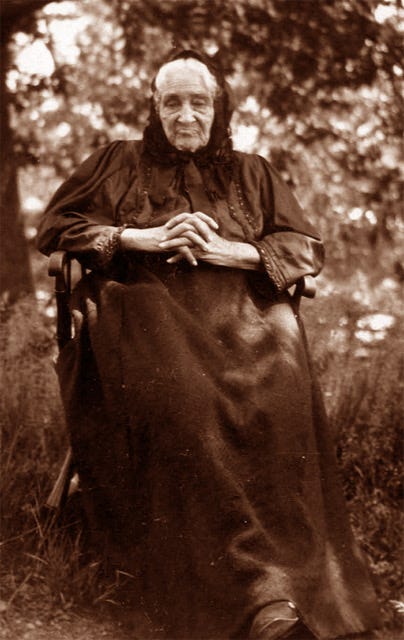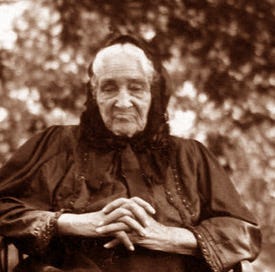Eunice R. Davis, Abolitionist Daughter of Andover: Part 1
Today we welcome a new History Buzz contributor, Christiana Boehmer.
Welcome or welcome back to History Buzz! If you’re a subscriber to the Buzz, thank you! If you’re new here, or you haven’t become a subscriber yet, please sign up for a subscription to have History Buzz delivered directly to your inbox. If you can, please consider a paid subscription to support the research and writing that make History Buzz possible.
This piece begins the story of Eunice R. Davis, Abolitionist Daughter of Andover. You can read Part 2 on April 17.
Among the leading abolitionists in Boston in the tumultuous decades leading up to the Civil War, one in particular stands out to me: Eunice R. Davis (1800-1901), a woman of color born and raised in Andover, Massachusetts. I live in Andover, and Eunice’s story captivated me as I wove it together from threads hidden in 19th century newspapers and documents. Eunice worked tirelessly for the cause, raising funds for abolitionist publications and Underground Railroad efforts, collecting signatures for petitions to end slavery and racial discrimination, sheltering formerly enslaved people who reached Boston, and making sure that antislavery groups respected the concerns of free Black people in the North.
In Eunice’s later years, all the major Boston papers published stories celebrating her life. Even the front page of The New York Times reported the 96th birthday of Eunice R. Davis, “the surviving member of the Woman’s Anti-Slavery Board of Boston, and the oldest female abolitionist in the United States.”1 / 2

Eunice was born in Andover in 1800, the daughter of Prince Ames and Eunice (Russ) Ames. (I’ll call her ‘Mother Ames.’) Prince Ames was a blacksmith who enlisted as a private in the Revolutionary War from 1777-1783,3 shivering through that infamous Valley Forge winter with a company of Andover men. Mother Ames was a weaver who’d grown up in Andover and attended South Church.4 The couple married in 1784 and raised ten children on the western side of town, near the Tewksbury line. Eunice cherished girlhood memories of skating there on Haggett’s Pond, then known as Five Mile Pond.
For Eunice, slavery was personal. Her own father Prince Ames had been enslaved by Capt. Benjamin Ames of Andover.5 Massachusetts laws in that time allowed slavery, and quite a few Andover households held one or more slaves.6 When Prince Ames enlisted as a soldier of the Revolution in 1777, he did so as substitute for his enslaver,7 a common practice. Due to a series of judicial decisions, slavery effectively ended in Massachusetts in the 1780s,8 and Prince Ames returned from the war a free man.
But Prince Ames was not of African descent; he was said to be “the son of an Indian mother and a white father.”9 And Mother Ames was the daughter of a white Andover woman and a Native American man who’d been enslaved in this town; when the couple was not allowed to marry legally, they eloped to Maine and “married Indian fashion.”10
So Eunice likely had white grandparents and Native American grandparents - and no African ancestors. At first, it surprised me that this committed abolitionist might not have claimed any African heritage. But I learned that white colonists enslaved many Native Americans.11 Enslaved people understandably found common cause regardless of heritage, and “Colonial records are replete with accounts of Africans and Indians, born worlds apart, brought together by history, circumstance, and personal choice.”12 The people in Eunice’s Black community descended from Native Americans, Africans, and Europeans. I don’t know if the distinctions mattered to them. I do know that Eunice joined organizations led by and for people of color, she married men of color, and she spent her life advocating for all people of color.
(In this piece, I’ll use the term “Black” as shorthand for “Black, Indigenous, People of Color” (BIPOC))
At age 18 Eunice married Robert Amos, and they moved to nearby Dracut, MA. Robert was reportedly also Native American. He ran a business keeping boats and bait on the Merrimack River.13 With the births of their children Dorcas, Charles, and George, the Amos family might have settled into a quiet life beside the river in Dracut. But Robert drowned in 1825.
When Eunice became a young widow with three small children, she turned to her network of friends and family. Eunice moved with her children to Boston, where her sister Lavina had married John Telemachus Hilton, a business owner and a leader in Boston’s Black community. Eunice’s new brother-in-law was “one of the founders of the Massachusetts General Colored Association in 1826…He was at the forefront of every political action taken by Boston’s African American community from these stirrings through the Civil War.”14
Eunice soon joined the Baptist church on Beacon Hill, also known as the African Meeting House. “In addition to serving as a spiritual and religious center for the community, the African Meeting House provided an integral gathering space for the cultural, educational, and political life of Boston’s Black community.”15 Eunice raised her children in the heart of the action, among Black Bostonians building community organizations and advocating for racial justice.
In 1833, Eunice married Rev. John Davis, a Baptist minister and tailor born in North Carolina. Her new husband served as president of the local Temperance Society for Black men, which he co-founded with John T. Hilton.16 The Boston-based abolitionist paper The Liberator announced Eunice’s marriage in its pages, a rare honor.17 In the decades following, the name of Eunice R. Davis appeared dozens of times in The Liberator.
The abolitionist movement picked up steam in the 1830s. Black leaders in Boston threw their support behind the racially integrated New England Anti-Slavery Society led by William Lloyd Garrison.18 Eunice joined the interracial Boston Female Antislavery Society (BFASS), and they elected her an officer in 1837.19 Hundreds of such societies formed in New York and Philadelphia and other Northern towns, but many of them elected only white leaders.
BFASS was a powerhouse among antislavery societies. Like other such groups, BFASS raised funds and distributed antislavery publications in Boston. But BFASS also acted beyond the borders of their city; they supported abolitionist lecture tours, orchestrated three national Antislavery Conventions of American Women, and coordinated multi-state campaigns to petition Congress to end or curtail slavery.20
Anti-slavery work demanded courage of Eunice and the women of BFASS. Most Bostonians opposed abolition, and were further incensed by females “agitating” on matters outside the domestic sphere. The BFASS women faced ongoing insults in the press and threats of physical violence. In 1835, an angry mob of several thousand men, described in local papers as “men of property and standing”, descended on a BFASS meeting. Theodore Lyman, the anti-abolitionist mayor of Boston, pressed Eunice and the others to flee, saying “Ladies, do you wish to see a scene of bloodshed and confusion? If you do not, go home.”21
During Eunice’s time with BFASS, the society initiated legal action that resulted in a significant abolitionist victory. In Commonwealth vs. Aves, a judge determined that an enslaved six-year-old girl brought here from New Orleans was entitled to remain free in Massachusetts rather than be returned to slavery in the South.22
The next part of this story of Eunice R. Davis will tell of her work on the Underground Railroad and improving the lives of Black people in Massachusetts.
Thanks for reading! Please leave us a comment, like, and subscribe. Your involvement helps make History Buzz visible to a wider audience of history-lovers, like you!
“Oldest Female Abolitionist; Mrs. Eunice Davis Celebrates Her Ninety-sixth Birthday,” New York Times, October 27, 1896, https://www.nytimes.com/1896/10/27/archives/oldest-female-abolitionist-mrs-eunice-davis-celebrates-her.html.
“Eunice Russ Ames Davis,” FindAGrave.com, accessed February 28, 2023, https://www.findagrave.com/memorial/30936528/eunice-russ-davis.
“U.S., Sons of the American Revolution Membership Applications, 1889-1970,” Vol. 126, s.v. “Prince Ames,” https://www.ancestry.com/discoveryui-content/view/285450:2204, Ancestry.com. Eunice’s great-grandson Charles William Revaleon applied for membership; his application lists evidence of Prince Ames’ service 1777-1783. Some news articles say that Prince Ames was also at Bunker Hill as servant to Tim Ames of Groton, but I haven’t found primary documents supporting that.
“Posthumous Sketches,” Andover Advertiser, December 17, 1853, https://mhl.org/sites/default/files/newspapers/AAD-1853-12.pdf. The article about Abraham Marland, Andover woolens manufacturer, says “He spun the yarn, and put out the cloth to be woven by people about town, among whom were Mrs. Prince Ames.” For South Church membership, see George Mooar, Historical Manual of South Church in Andover 1859, 1859, https://archive.org/details/historicalmanual00south.
Charlotte Helen Abbott, “Early Records of the Ames Family of Andover,” accessed February 28, 2023, https://mhl.org/sites/default/files/files/Abbott/Ames%20Family.pdf. See also Franklin A. Dorman, Descendants of Prince Ames of Andover, Massachusetts, unpublished notes ca 2012, courtesy Dedham Historical Society and Museum. Some other accounts suggest that Prince may also have been enslaved for a time by Ames family members in Groton.
Joan C. Patrakis, Andover Persons of Color Project, Andover Center for History & Culture, 2022, https://sites.google.com/andoverhistoryandculture.org/database/home. Also, Edward L. Bell, Persistence of Memories of Slavery and Emancipation in Historical Andover, (Boston: Shawsheen Press, 2021).
“Sons of the American Revolution,” Ancestry.com. The Department of the Interior document confirms that Prince Ames in 1777 “substituted for Benjamin Ames.” Prince Ames may or may not have been freed before enlisting.
“History of slavery in Massachusetts,” Wikipedia, last modified January 19, 2023, https://en.wikipedia.org/wiki/History_of_slavery_in_Massachusetts.
Charlotte Helen Abbott, “Historical Andover - No. 107 concluded - Debora Russe,” Andover Townsman, July 12, 1901, 2, https://mhl.org/sites/default/files/newspapers/ATM-1901-07.pdf. News articles during and after Eunice’s lifetime describe various blends of Native American and European heritage; a rare few suggest possible African heritage as well. See discussion in Gail Coughlin and the Dedham Historical Society, “History Tidbits: Eunice Russ Ames Davis, Activist, Abolitionist, Dedham Resident, Part 2”
Abbott, “Debora Russe.” Also, for more on how Eunice’s maternal grandfather Peter and his sister Kate successfully sued Moody Bridges of Andover for their freedom, see North Shore Slavery, http://northshoreslavery.com/freedomcases/index.php.
Laurie Tamayo, “A Brief Background on Indigenous Enslavement,” in Stolen Relations: Recovering stories of indigenous enslavement in the Americas, November 21, 2022, https://indigenousslavery.org/2022/11/21/a-background-on-indigenous-enslavement/.
James O. Horton and Lois E. Horton, In Hope of Liberty: Culture, Community and Protest Among Northern Free Blacks, 1700-1860, (Oxford University Press, 1998), 38
Abbott, “Debora Russe.”
Kathryn Grover and Janine V. da Silva, “Historical Resource Study, Boston African American National Historic Site,” December 31, 2002, https://www.nps.gov/parkhistory/online_books/bost/hrs.pdf. See also “John T. Hilton,” Wikipedia, last modified August 7, 2022, https://en.wikipedia.org/wiki/John_T._Hilton.
National Park Service, “African Meeting House,” last modified August 10, 2021, https://www.nps.gov/boaf/learn/historyculture/amh.htm.
“Temperance Meeting,” The Liberator, April 20, 1833, https://ark.digitalcommonwealth.org/ark:/50959/mc87rp43w.
“Married,” The Liberator, October 26, 1833, https://ark.digitalcommonwealth.org/ark:/50959/mc87rq85m. For John’s occupation and birthplace, see his death record https://familysearch.org/ark:/61903/3:1:S3HY-6S6H-16.
“Massachusetts General Colored Association,” Wikipedia, last modified July 7, 2020, https://en.wikipedia.org/wiki/Massachusetts_General_Colored_Association.
Boston Female Anti-Slavery Society, Right and Wrong in Boston: Annual Report of the Boston Female Anti-Slavery Society With a Sketch of the Obstacles thrown in the way of Emancipation by certain Clerical Abolitionists and Advocates for the subjection of Women in 1837, (Boston: The Society, 1837), 89, https://archive.org/details/annualreportbos01socigoog/page/n93/mode/2up
Debra Gold Hansen, “The Boston Female Anti-Slavery Society and the Limits of Gender Politics,” in The Abolitionist Sisterhood: Women’s Political Culture in Antebellum America, Jean Fagan Yellin and John C. Van Horne, editors. (Cornell University Press, 1994), 45.
Boston Female Anti-Slavery Society, Report of the Boston Female Anti Slavery Society: with a concise statement of events, previous and subsequent to the annual meeting of 1835 (Boston: The Society, 1836), https://archive.org/details/ASPC0002429400. See also Josh S. Cutler, The Boston Gentlemen’s Mob: Maria Chapman and the Abolition Riot of 1835, (Charleston, SC: The History Press, 2021).
Boston Female Anti-Slavery Society, Right and Wrong in Boston in 1836: Report of the Boston Female Anti-Slavery Society: Being a concise history of the slave child, Med, and of the women demanded as slaves of the Supreme Judicial Court of Mass, with all the other proceedings of the Society (Boston: The Society, 1836), https://archive.org/details/annualreportofbo1836bost/page/n1/mode/2up. See also “Commonwealth vs. Aves,” Wikipedia, last modified January 24, 2023, https://en.wikipedia.org/wiki/Commonwealth_v._Aves.





This is a fascinating story. The enslavement of Native Americans has not been widely discussed.
Thank you for this very interesting and compelling research and history.